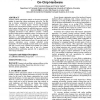Free Online Productivity Tools
i2Speak
i2Symbol
i2OCR
iTex2Img
iWeb2Print
iWeb2Shot
i2Type
iPdf2Split
iPdf2Merge
i2Bopomofo
i2Arabic
i2Style
i2Image
i2PDF
iLatex2Rtf
Sci2ools
CASES
2003
ACM
2003
ACM
Frequent loop detection using efficient non-intrusive on-chip hardware
Dynamic software optimization methods are becoming increasingly popular for improving software performance and power. The first step in dynamic optimization consists of detecting frequently executed code, or “critical regions.” Previous critical region detectors have been targeted to desktop processors. We introduce a critical region detector targeted to embedded processors, with the unique features of being very size and power efficient, and being completely non-intrusive to the software’s execution – features needed in timing-sensitive embedded systems. Our detector not only finds the critical regions, but also determines their relative frequencies, a potentially important feature for selecting among alternative dynamic optimization methods. Our detector uses a tiny cache coupled with a small amount of logic. We provide results of extensive explorations across seventeen embedded system benchmarks. We show that highly accurate results can be achieved with only a 0.02% power o...
| Added | 05 Jul 2010 |
| Updated | 05 Jul 2010 |
| Type | Conference |
| Year | 2003 |
| Where | CASES |
| Authors | Ann Gordon-Ross, Frank Vahid |
Comments (0)

